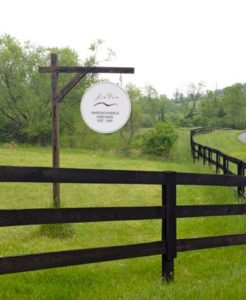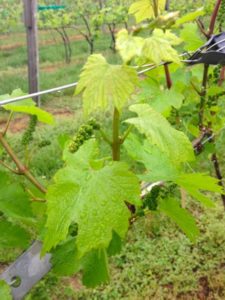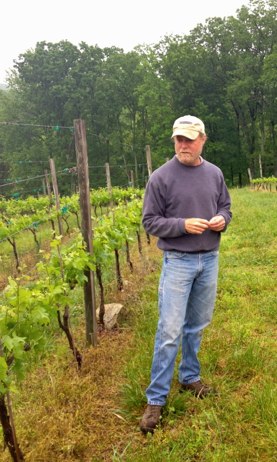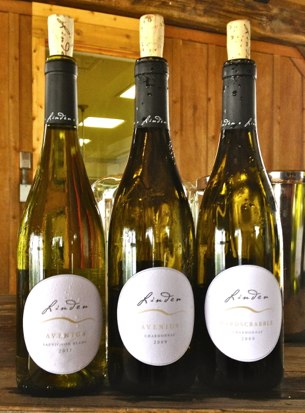 For our final Taste Camp vineyard walk, we ventured outside of Loudoun County to Fauquier County for a Sunday morning with one of Virginia’s great winemakers, Jim Law of Linden Vineyards.
For our final Taste Camp vineyard walk, we ventured outside of Loudoun County to Fauquier County for a Sunday morning with one of Virginia’s great winemakers, Jim Law of Linden Vineyards.
As you drive out there, and it is out there (65 miles west of DC), you’re struck by the beauty, rolling hills and climate change. You’re now in the Blue Ridge Mountains. This particular morning was about 15 degrees cooler than the previous already hot Virginia days. As we stepped out into the original Hardscrabble Vineyards, the clouds thickened creating a gentle background for soft spoken Jim to share his years of wisdom.
 Jim is a learner, a tinkerer. He’s very patient and methodical. He grew up in Ohio with wine loving parents. In the Peace Corps in Zaire, Jim discovered he loved agriculture and in particular growing grapes. After returning to Ohio, he decided to move to Virginia to pursue this passion in 1981. He purchased an abondoned Hardscrabble farm in 1983, planted grapes and after years of hard work, released Linden’s first vintage in 1988 with the opening of the winery. Jim has been working grapes and wine in Virginia for 30 years, now producing about 4,000 cases per year.
Jim is a learner, a tinkerer. He’s very patient and methodical. He grew up in Ohio with wine loving parents. In the Peace Corps in Zaire, Jim discovered he loved agriculture and in particular growing grapes. After returning to Ohio, he decided to move to Virginia to pursue this passion in 1981. He purchased an abondoned Hardscrabble farm in 1983, planted grapes and after years of hard work, released Linden’s first vintage in 1988 with the opening of the winery. Jim has been working grapes and wine in Virginia for 30 years, now producing about 4,000 cases per year.
 We started off in one of the original Chardonnay vineyards planted in 1985. This is one of the few original plantings still left. Why? Because Jim’s key philosophy is ‘match the grape type to the soil type.’ Then the wine makes itself in the vineyard. He learned this early on in his work in Virginia. But as a pioneer in Virginia, he had to learn which soils matched which grapes. He’s discovered the ideal sites on his land to grow everything from Riesling to Vidal Blanc to Cabernet Sauvignon. He’s currently in a five to ten year plan to reorganize his vineyards…Hardscrabble Vineyards’ 25 acres, Avenius Vineyards’ five acres and Boisseau Vineyards’ four acres…in this way. Starting from his 2009 red wines, you’ll taste the bigger results.
We started off in one of the original Chardonnay vineyards planted in 1985. This is one of the few original plantings still left. Why? Because Jim’s key philosophy is ‘match the grape type to the soil type.’ Then the wine makes itself in the vineyard. He learned this early on in his work in Virginia. But as a pioneer in Virginia, he had to learn which soils matched which grapes. He’s discovered the ideal sites on his land to grow everything from Riesling to Vidal Blanc to Cabernet Sauvignon. He’s currently in a five to ten year plan to reorganize his vineyards…Hardscrabble Vineyards’ 25 acres, Avenius Vineyards’ five acres and Boisseau Vineyards’ four acres…in this way. Starting from his 2009 red wines, you’ll taste the bigger results.
Jim’s inspiration comes from Europe in growing and winemaking, particularly France’s non-Mediterranean viticultural areas that experience similar situations to the Virginia mountains. He likes elevation…we were at 1,300 feet with breezy, cool, damp, moist conditions. He likes minerality and vibrant acidity.
Over in the Hardscrabble Merlot vineyard, we saw Jim’s philosophies at work. He grafted Merlot over a Carmenère experiment. The grape works in Bordeaux so he thought he’d give it a shot. But no fruit was produced so he changed to Merlot as it likes the clay soil and it’s a hardy grape. Jim spent time in Bordeaux this winter to focus on Merlot.
“Every year is different which makes it interesting.” The bird pest issues are getting worse so more and more netting is required each year. Grapevine yellows have also struck here. The cherry tree host was taken down to stop the spreading. Jim prefers a normal year like 2008 and 2009. In these years, you can express terroir, unlike 2010 which was just easy.
“Climate is what you plan for and weather is what you get,” Jim quoted Mark Twain. His fear on the 2012 early ripening is an early harvest. It could force August picking of the whites which then miss the cool nights they need for the final development of the grape prior to harvest. And picking decisions are very complex. In whites, he looks for mineral acidity not green apple. In reds, he wants tannin. Jim picks 150 grapes and tastes for acidity or tannins over several days. When they peak, they’re harvested.
Our last stop, the crush pad. As Jim poured some of his proud wine examples, the fog thickened and the mist began. Jim’s philosophies rang true as we tasted.
- 2011 Avenius Sauvignon Blanc: He loves this wine, even though in his 32 vintages, 2011 was the worst ever. This grape needed just three to four more days on the vine, but as the rains continued in September, they wound up picking in pouring rain to get it off the vine. We tasted that green apple acidity but he said it should be gone after three to four more months in the bottle.
- 2009 Avenius Chardonnay: This wine is the Chablis-style like he likes. 2009 was a great year for white. This one had a tropical nose and fruity white pepper taste.
- 2009 Hardscrabble Chardonnay: This wine came from the buds we first saw on the vineyard, the oldest vines. You could taste the complexity and depth coming through.
- 2008 Hardscrabble Red: 2008 was a classic red year. This combination of 71% Cabernet Sauvignon, 15% Cabernet Franc, 7% Petit Verdoux and 7% Merlot was full of cherry and cedar.
- 2008 Avenius Red: At 72% Petit Verdoux and 28% Cabernet Sauvignon, we heard from Jim, as the other Virginia winemakers we spent time with, about Petit Verdoux being a big grape. Because of that, it’s the only varietal red they do. This combination was caramel and red fruit forward.
Linden’s website states the feeling you get from Jim…”never content.” That’s great news for wine lovers as there are many more years of great winemaking to come from this Virginia classic.
That wraps up Taste Camp 2012. Thank you for coming along on what was a great journey through DC’s Wine Country!
For more on Jim’s vineyard and winemaking approach, visit his website.


